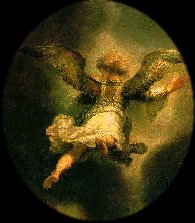 1606 - 1669
1606 - 1669Rembrandt Harmenszoon van Rijn
 1606 - 1669
1606 - 1669

Rembrandt's Members of the Drapers' Guild, or, Syndics of the Clothmasters' Guild, painted in the year 1662. It is just after sunset, you are standing in the silent Rijksmuseum, Amsterdam.
On the long wooden bench in front of you are two gentlemen, gazing at the very same portrait. One is a beautiful blond demon, an eternal youth. The other is a rather distinguished elderly Englishman. At the moment they seem completely enraptured, caught in an intense study of the beneficent faces returning their scrutiny.

"With each portrait he understood the grace and goodness of mankind ever more deeply. He understood the capacity for compassion and for wisdom which resides in every soul.
But nowhere is this spiritual depth and insight more clearly manifest than in Rembrandt's self-portraits.
Tale of the Body Thief
On Lestat's theory about Rembrandt:
Why do you think he painted so many? They were his personal plea to God to note the progress of this man who, through his close observation of others like him, had been completely religiously transformed.
'This is my vision,' said Rembrandt to God."
by Anne Rice


Here are some of the self-portraits Rembrandt left to us to trace his journey through time.
Rembrandt is indeed in the faces of his subjects. He transferred his divinity to them all, along with the profound secret he appeared to contain, an unattainable capacity for understanding seemingly beyond the grasp of ordinary mortals.And yet, is his life progression as glimpsed through his self-portraits a result of some transcendental religious experience? I rather think that he was conducting an experiment. See the face of a young man, he perhaps thought, and that of the same man when he is old, with his life fading. Hold the two together and has anything greatly changed? Does the bright soul of youth still shine under the scarring of lengthy existence? And if not, exactly when does time begin to remold the unformed countenance?
In Rembrandt's case, you can decide. Here was a man who epitomized godliness with his very expression. Rembrandt was a living reference for the vague realm of mysticism.
And so, was Rembrandt inevitably transformed? Is it wisdom we see in his face at the very end? The kindness, compassion, patience and perception truly seem to be immortal qualities in this man, and yet what one might call a reflection of wisdom I would call sadness. More truly a melancholy sadness suffused with soft mirth and disillusionment, tempered above all, by an insightful acceptance.

Age 23
Age 28
Age 34
Age 54
Age 63
Age of death